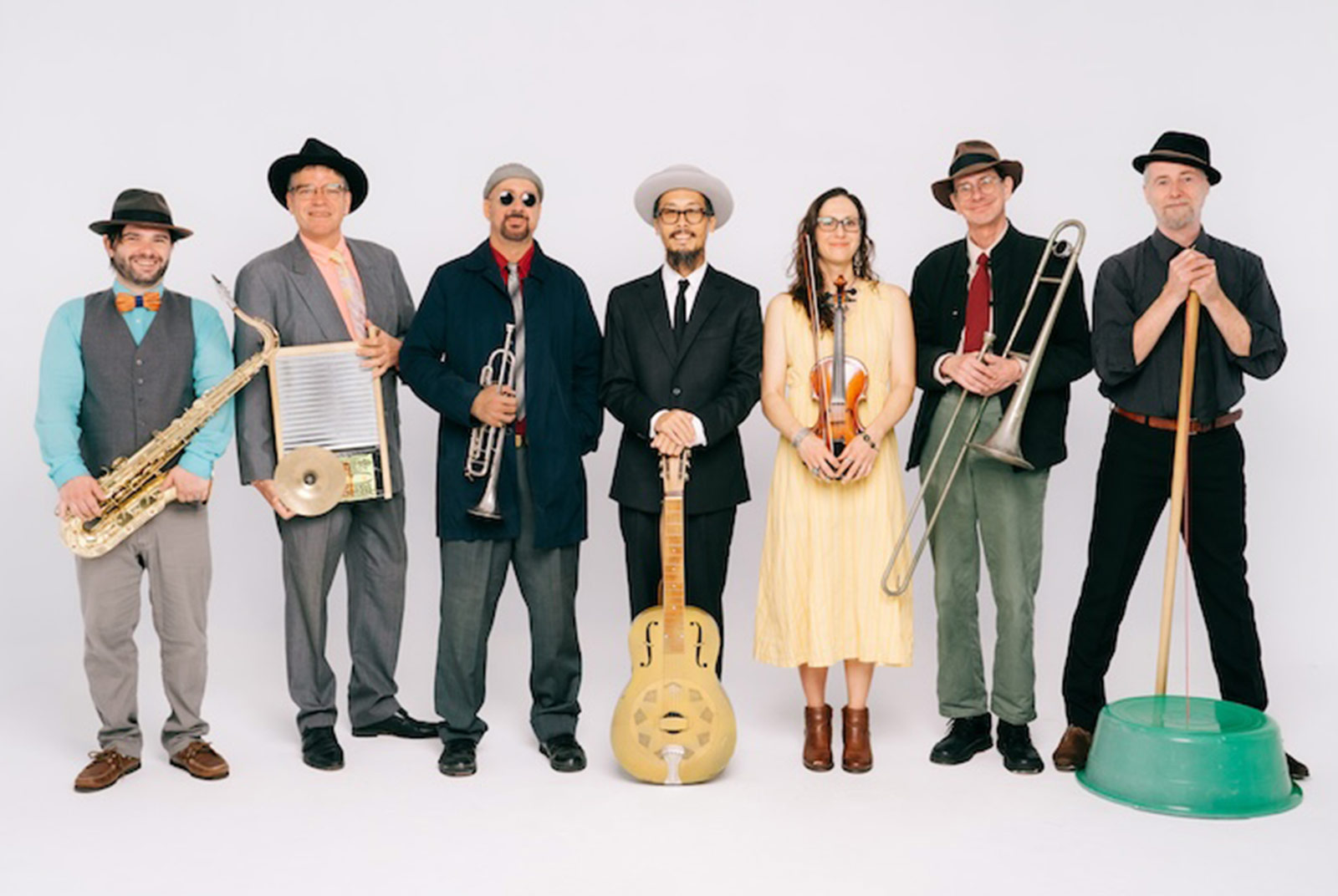#Taiwander Submission
Thriving in Taiwan Culture of Tolerance
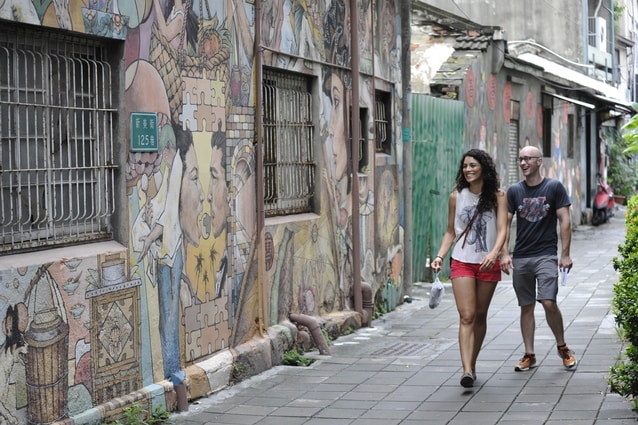
Source:Kuo-Tai Liu (for illustrative purpose)
The members of Taiwan foreign community are increasingly engaged in society, willing to slog hard, always appreciative of the opportunities for which they had to fight. Over the years, they have also contributed to an increasingly cosmopolite society that welcomes and values the input from minorities at all levels of governance.
Views
Thriving in Taiwan Culture of Tolerance
By Dimitri Bruyasweb only
This article is a selected submission for the #Taiwander open call, written by Dimitri Bruyas
The rapid growth of the population of foreign origin and their families in the last two decades has led to new evolutions in society. Unlike some countries against immigration and immigrants, Taiwan not only celebrates cultural differences, but also promotes the integration of foreign influences across education, culture, entertainment and more.
According to statistics from the Ministry of the Interior, a total of 715,080 foreign residents have called Taiwan their home as of February 2018, including foreign workers (blue- and white-collar workers) and spouses of Taiwan nationals and their children. Among them, more than two-thirds come from mainland China, Hong Kong or Macau while another 28 percent are from Southeast Asia, predominantly Vietnam, Indonesia, Thailand, the Philippines and Cambodia.
Building Cultural Bridges with Taiwan
Regarding the offspring of new immigrants, the ministry also indicates that almost six in ten children can speak their foreign-born parents’ native language at various degrees, thanks to their families’ support and the government push to promote “mother language learning.” Such dual education has helped many children to define themselves as having a “dual identity” or being “biculturals” for the benefit of the community.
Like their Taiwan counterparts, new immigrants’ children are full of energy and optimism. Still, one major difference remains overtime: they often adapt their attitudes, behaviors and values more easily to other culture, meaning that they swiftly blend in wherever they live. After all, they are equally Taiwanese and Vietnamese, Indonesian, Canadian, South Korean or American as they take part, to varying degrees, in the life of two or more communities. The same is true for my two children, Tanya, 14, and Chloe, 7, who were born and raised in Taiwan.
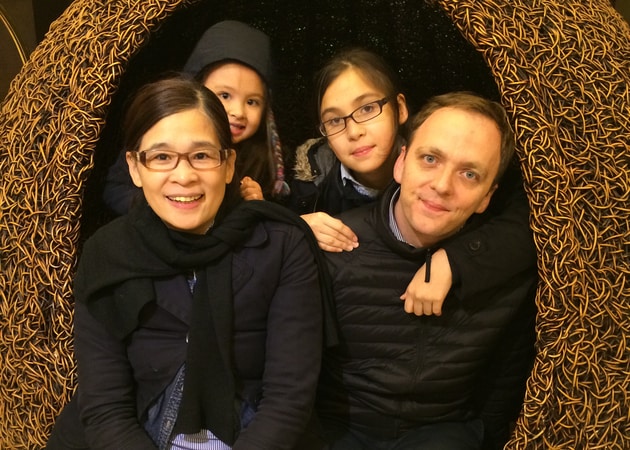 Dimitri Bruyas has been living in Taipei with his family, Jennifer, Chloé and Tanya, since 1999. (Image: Dimitri Bruyas)
Dimitri Bruyas has been living in Taipei with his family, Jennifer, Chloé and Tanya, since 1999. (Image: Dimitri Bruyas)
When she was in elementary school, Tanya couldn’t see the difference between herself and her best friends. She was often taken aback by questions about her home country, which she considered as Taiwan; until she eventually grew up and graduated from Xing An Elementary School. That year, my wife and I finally understood her quest for “identity” as we edited her first book, “Don’t ask me where I come from” that gave us an insight on the way she had developed her unique personality.
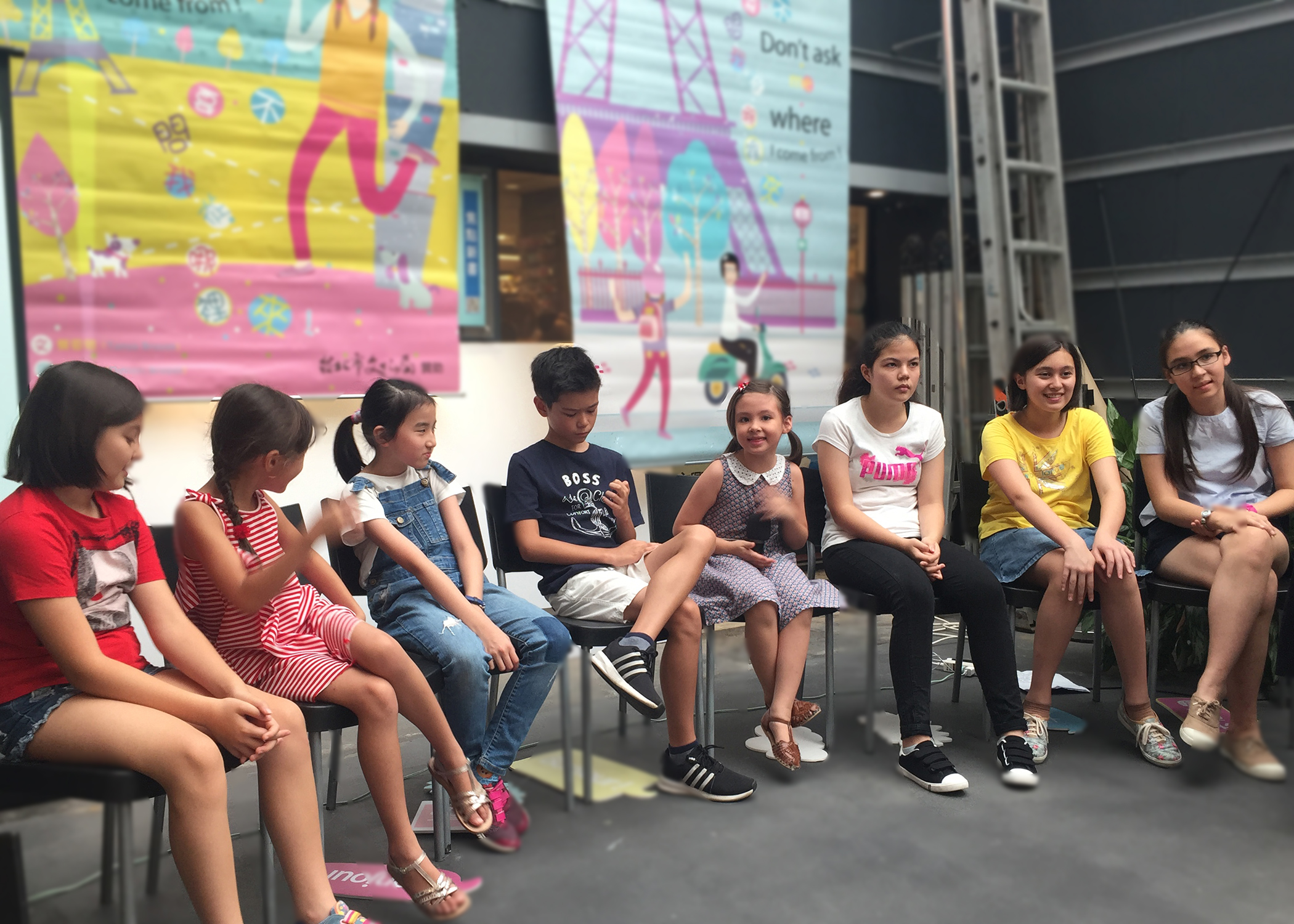
The plot centers on her alter ego’s journey to discover the wonders of Taipei – the natural landscapes, the foods and the people – and, by extension, her “dual identity.” The book also exposed her ability to carefully weigh the merits of alternative perspectives and integrate them into a coherent whole. Like in real life, the main character in her book is equally good at recombining different existing ideas to make new connections between concepts like family, food and school life.
 One of the highlights of this book is the colors, which are used like a universal, nonverbal language, to better leverage emotions and behaviors among the young and the young at heart. (Courtesy of Dimitri Bruyas)
One of the highlights of this book is the colors, which are used like a universal, nonverbal language, to better leverage emotions and behaviors among the young and the young at heart. (Courtesy of Dimitri Bruyas)
To Tanya, the project further aimed at encouraging children of new immigrants to be proud of their dual culture and bringing greater tolerance within and between various communities in Taiwan. To me, illustrating her book was also a chance to educate others about new migrants’ dual cultures which are like the two sides of the same coin. How do you greet someone in Taiwan, Belgium or France? What sports do children like in either countries? These are down-to-earth questions asked by children of all ages.
Still, they highlight children’s ability to take advantage of Taiwan culture of tolerance to build cultural bridges between their “home” and the “home of their parent(s)” that will help them thrive in their personal and professional lives.
I am especially confident that these multiple connections will inspire the next generation of Taiwan leaders who will be able to use their “dual cultures” to break the stalemate.
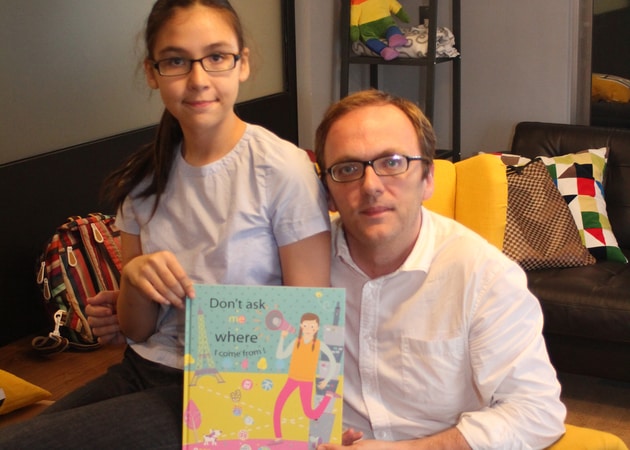 Tanya and Dimitri published “Don’t ask me where I come from” in 2016. (Image: Dimitri Bruyas)
Tanya and Dimitri published “Don’t ask me where I come from” in 2016. (Image: Dimitri Bruyas)
Sharing Love, Enthusiasm and Expertise with Taiwan
There is no age limit for sharing though. During my 19 years in Taiwan, I have met so many foreigners, young and old, who have been equally passionate about this tiny country and dedicated to share their love, enthusiasm and expertise along the way. Looking for such inspiring individuals was part of my job for about 10 years as the managing editor of Discover Taiwan, a quarterly magazine about art, food, style and travel, for which I travelled extensively. Have you ever heard of Dr. Samuel Noordhoff, Father Brendan O’Connell or Dr. Olav Bjorgaas? Let me introduce them properly.
Better known in Taiwan by his Chinese name Luo Huei-fu, which means “man of wisdom,” Dr. Samuel Noordhoff made the decision to practice medicine and spread God’s love, shortly after graduating with a medical degree from the University of Iowa, in a time when travelling to Taiwan required a 20-day-long journey by boat. Over his many years here, Dr. Noordhoff served as president of both the Mackay Memorial Hospital and the Chang Gung Memorial Hospital, playing an instrumental role in establishing a system for development of medicine for all of Taiwan.
Along the way, he also established many milestones in Taiwan medical sector, including the first polio rehabilitation center, the first suicide prevention center, the first burn center and intensive care unit, and the first craniofacial treatment center. During my encounter with Noordhoff in 2013, I was literally blown away by the achievements of this kind and dedicated professional whose Noordhoff Craniofacial Foundation has been instrumental in changing the lives of so many young people in Taiwan and around the world.
 Dr. Samuel Noordhoff is greeted by one of his former patients. (Image: Dimitri Bruyas)
Dr. Samuel Noordhoff is greeted by one of his former patients. (Image: Dimitri Bruyas)
Another inspiring person is Father O’Connell who arrived in Taiwan in the early 1960s. At that time, he saw many underprivileged families with children in need and decided to do what he could to help. He has since dedicated the majority of his existence to bettering the lives of others, spending more than 50 years in pursuit of charity and good will, speaking only in English in the beginning, then advancing to Chinese, Taiwanese and even the tribal language of the indigenous Atayal people.
More importantly, O’Connell established the first registered day care institute for developmentally challenged children in Taiwan. There is, therefore, little wonder that he was the first foreigner to obtain Taiwanese nationality without having to give up his American citizenship under amendments to the Nationality Act that allow foreigners who make outstanding contribution to Taiwan to become dual citizens.
Last but not least, it is also with great emotion that I remember my encounter with Dr. Olav Bjorgaas, a missionary who also came to Taiwan to share love and medical expertise. The newlywed Norwegian missionary arrived with his wife in 1954 under the direction of the Norwegian Missionary Society to serve at the Losheng (Happy Life) Sanatorium, a medical shelter for leprosy patients in today’s New Taipei area. Being “a good news living among the people,” the medical doctor then helped the physically challenged in Puli and Pingtung, southern Taiwan, between the 1950s and 1980s.
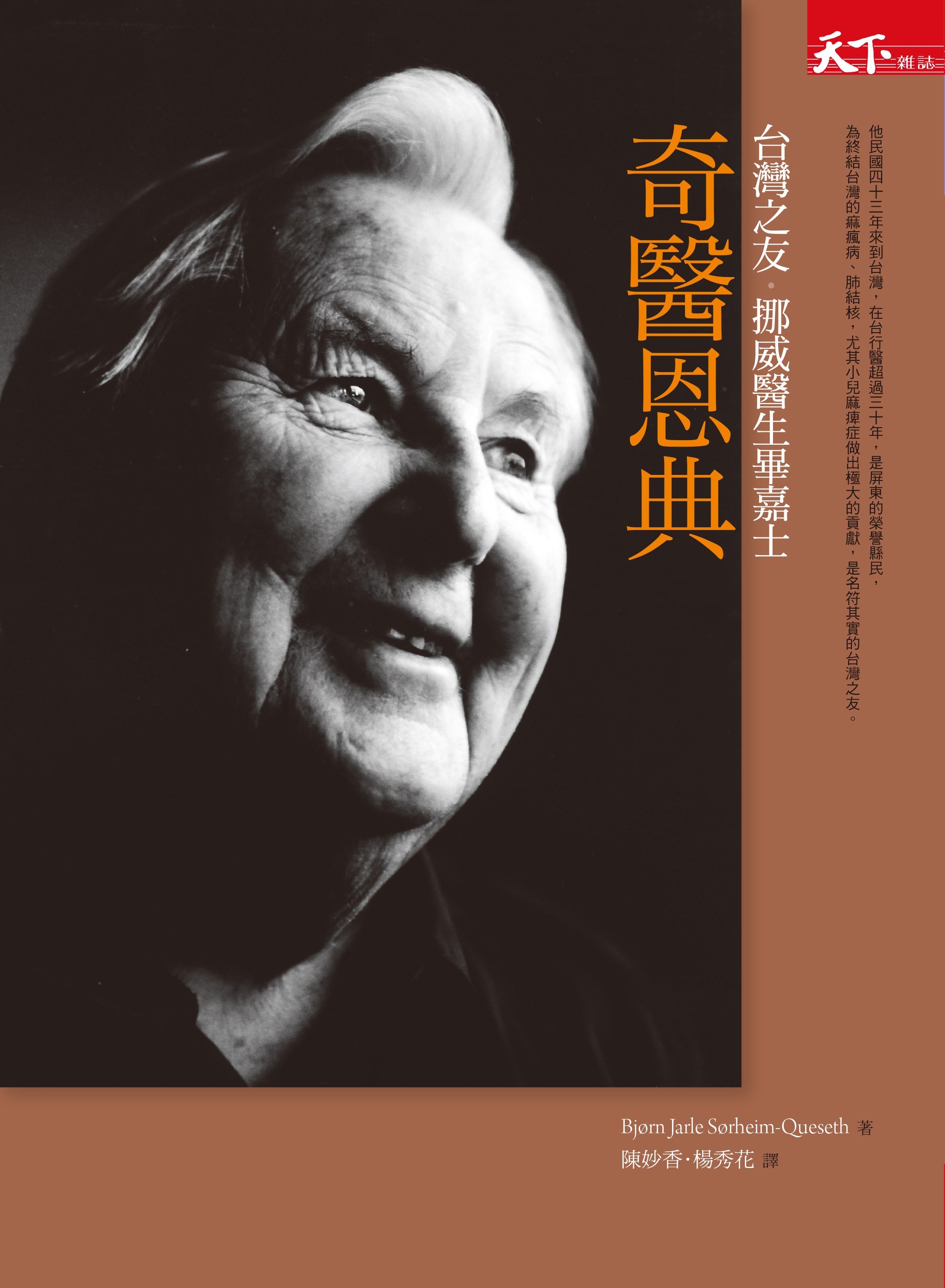 Dr. Olav Bjorgaas is pictured on the cover of his book published by CommonWealth Publishing in September 2013. (Image: CommonWealth Publishing)
Dr. Olav Bjorgaas is pictured on the cover of his book published by CommonWealth Publishing in September 2013. (Image: CommonWealth Publishing)
In a country where medical resources were scare, lepers were rejected from society but Dr. Bjorgaas worked tirelessly on giving them back their dignity by providing proper medical care. With a group of medical personnel from the U.S., Norway and Finland, he co-founded a “foreigner hospital” in Pingtung – today’s Pingtung Christian Hospital (PCH) – as well as the country’s first center for disabled children, “Victory Home.”
By taking care Taiwanese people as if they were members of their own family, no matter their medical condition, Noordhoff, O’Connell, Bjorgaas and so many other outstanding individuals have set the standard and an example for both the members and friends of the foreign community in Taiwan. They have taught us all a valuable life lesson in the process too.
Becoming Ambassadors of Taiwan Culture of Tolerance
At a time when an increasing number of young people do serious soul-searching about their future in Taiwan, it is very important to remember the contributions made by these foreigners to the development of a modern society.
We must also encourage and thank the many young entrepreneurs, students, teachers and artists of foreign origin who are participating in/witnessing the never-ending transformation of Taiwan.
Among the many ambassadors of culture, I would cite photographer Hubert Kilian who has been recording the disappearing of the “old Taipei” through his beautiful black and white photos. Thanks to his commitment, we all know about the Huaguang Community, one of Taipei’s oldest communities seated at the crossing of Hangzhou South Road and Aiguo Road, which was demolished in disrespect of its historical value a few years ago?
Kilian’s latest book, “Visages de Taipei” (Faces of Taipei), is a tribute to the urban history of the capital city. The French photographer has been roaming the streets of Taipei and its suburb areas for more than 15 years, meeting with local residents during their night wandering in a bid to capture the hidden beauty and spirit of this giant metropolis and share it with future generations.
On a different note entirely, I would also commend Nicholas Palumbo and Simon Thomas who embarked on a journey to promote the heritage and original process of making tea, stepping away from Taiwan’s fast-growing coffee culture. The two expats went from enjoying tea as an occasional refreshment to realizing the impact, history and significance of tea in Taiwan and all over the world. Their fascination of knowing variations of teas are all derived from one single species of tea leaf motivated them to set up their business on Kickstarter, the world’s largest funding platform for creative projects. Today, Dachi Tea Company aims to give tea culture a “globally appealing face” with a little twist from Taiwan.
For my part, I have also tried to share the uniqueness of Taiwan architecture, culinary arts and contemporary arts on the international stage in my work as a writer and photographer. Among other highlights, my bilingual books on Taichung-based sculptor Li Chen published in 2014 and 2016 were a chance to look through the eyes of a famous Taiwanese artist to catch a glimpse of his art and put it in plain words for the international viewers. Many artists, chefs and entrepreneurs deserve to be known outside of Taiwan too, and the opportunities are numerous.
Having a sound understanding of the local culture, however, is necessary to unveil its inner beauty, the whys and wherefores, as well as considering the aesthetics of the result.
To the members and friends of Taiwan’s foreign community, this is also a chance to act as ambassadors of Taiwan’s culture of tolerance and contribute to the marketing of Taiwan beyond Asia. Beyond, this could be a way of showing our appreciation for the opportunities we have received here, while immigration and immigrants are increasingly decried elsewhere.
Edited by HanSheng Huang
About the Author
Dimitri Bruyas is a seasoned reporter, commentator and news editor based in Taiwan. He is also an illustrator, photographer and art book publisher who writes on subjects ranging from business to modern art, design, fine dining and architecture. His work has been published throughout the Asia Pacific region, as well as in Europe and the United States.
This article is a submission from Dimitri Bruyas for the #Taiwander open call. It presents the opinion or perspective of the original author, which does not represent the standpoint of CommonWealth magazine.
Additional Reading
♦ No More Stereotypical Filipino─‘PhilTai The Voice’ Founder Gen
♦ 'Staying in Taiwan is good, But Returning to My Homeland is Better'
♦ Our Generation Sees ‘Others’ More Openly






